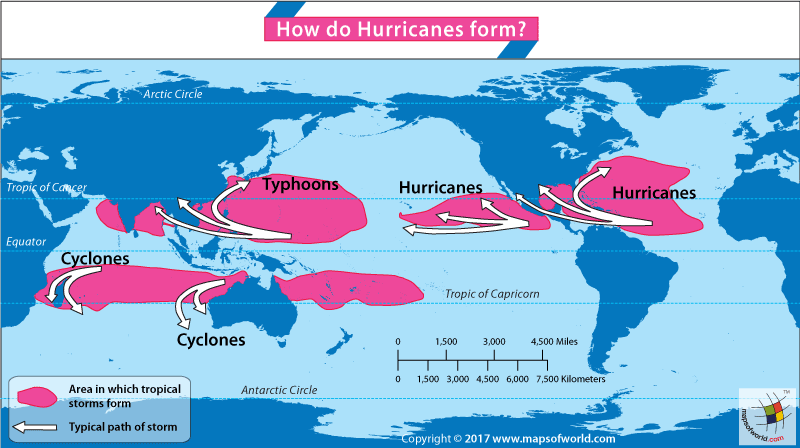How Do Hurricanes Form?
Hurricanes are rather large and severe tropical storms that form over the warm waters of the North Atlantic Ocean, particularly in the Caribbean Sea and the Gulf of Mexico. Hurricanes may also form over the northern, eastern, and southern Pacific Ocean. They are accompanied by swirling winds at very high speeds (usually between 74 and 136 miles per hour). Hurricanes often bring heavy rains, lightning, and thunderstorms. They can cause much damage when they strike land. Hurricanes also cause sea surges – a flood that often inundates the coastal areas by water that is pushed ashore by the storm – sometimes referred to as a ‘wall of water.’ Hurricanes can be large storms stretching up to 600 miles.
From Disturbance to Hurricane
Scientists and meteorologists say that there are three factors that lead to the formation of a hurricane – warm ocean waters, overhead clouds, and a high humidity/moisture levels, in the region where these hurricanes are formed. They often start out as a tropical disturbance that builds over warm ocean waters. The warmth of the waters fuels the disturbance with the energy needed for it to escalate into a storm, and potentially turn into a hurricane. These storms form over oceans where the surface temperature is over 79 degrees Fahrenheit, or about 26 degrees Celsius.
Another factor that leads to the formation of hurricanes is winds that blow at steady speeds without dissipating the storm. These winds start to rotate around what becomes the Eye of the storm. This core region has light winds and remains relatively clear while thunderstorms swirl around it. When the wind speeds of a tropical disturbance are less than 38 miles per hour, they are referred to as tropical depressions. When wind speeds are higher, they come to be known as tropical storms. A tropical storm escalates into a full-blown hurricane when its wind speeds reach 74 miles per hour.
Formation of A Hurricane
- Hurricanes form due to a phenomenon called the Coriolis Force which causes the winds in hurricanes to rotate clockwise in the Northern Hemisphere and counterclockwise in the Southern Hemisphere.
- The warm waters of the oceans evaporate and rise. Together with the moisture content in the air they condense and form massive rain clouds.
- The process of evaporation also leaves a low-pressure column rising from the surface of the ocean waters to the clouds. This column attracts cooler air from the surrounding areas.
- This cold air warms up near the surface of the ocean and again starts to twist into a swirling mass and rise again in turn attracting air from high pressure regions around this column, gathering strength and speed as it intensifies
- The air that rises is ejected from the top of the hurricane, thus sustaining the low-pressure column at the center forming the eye through which cooler air descends.
- The tropical winds help the hurricanes move inland, though the exact course that a hurricane may take is quite unpredictable.
- Hurricanes dissipate due to natural causes. After making a landfall, the hurricane starts to weaken due to lack of warm waters to sustain the pressure. If a hurricane moves towards colder Arctic waters it again loses much of the pressure that is necessary to sustain its strength.
Tropical Cyclones and Typhoons are weather phenomena that are similar to Hurricanes. Severe storms that develop over the western Pacific are called Typhoons and those forming over the Indian Ocean are called Tropical Cyclones.
Know more:
Related Maps:





